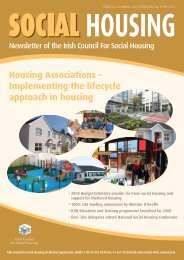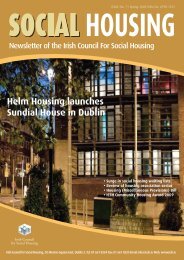National Housing Strategy for People with a Disability 2011 - 2016
National Housing Strategy for People with a Disability 2011 - 2016
National Housing Strategy for People with a Disability 2011 - 2016
You also want an ePaper? Increase the reach of your titles
YUMPU automatically turns print PDFs into web optimized ePapers that Google loves.
persons <strong>with</strong> moderate disabilities, who wish to remain independent in their own home,should be able to do so <strong>with</strong>out the need <strong>for</strong> costly and disruptive remodelling of thedwelling. This criterion supports the Government commitment to enable older people toremain in their own homes <strong>for</strong> as long as possible in line <strong>with</strong> the ‘ageing in place’ concept.8.18 Furthermore, the DECLG publication, Guidelines <strong>for</strong> Planning Authorities onSustainable Residential Development in Urban Areas (2009) underpins the principle ofuniversal design in the development of sustainable neighbourhoods. The Programme <strong>for</strong>Government also contains a commitment to promote and support universal design wherebyall environments can be used to the greatest extent possible by all people, regardless ofage, ability or disability.8.19 Currently, a number of local authorities, in their Development Plans and <strong>Housing</strong>Strategies, cite the concept of lifetime housing as a mechanism to meet the needs of people<strong>with</strong> disabilities and also outline targeted commitments to develop wheelchair accessibleunits. In the absence of any national standards, separate uncoordinated moves towards theconcept of lifetime housing in different areas has the potential to lead to a haphazardapproach, <strong>with</strong> no guarantee that the dwellings delivered will meet the needs of peoplethroughout their lifecyle, or that they would be cost effective.UK Situation8.20 In the early 1990s in the UK, the Joseph Rowntree Foundation developed theconcept of lifetime homes. The Lifetime Homes Standard was established in the mid-1990sto incorporate a set of principles that should be implicit in good housing design. Gooddesign, in this context, is considered to be design that maximises utility, independence andquality of life, while not compromising other design issues such as aesthetics or costeffectiveness. The Lifetime Homes Standard seeks to enable ‘general needs’ housing toprovide, either from the outset or through simple and cost effective adaptation, designsolutions that meet the existing and changing needs of diverse households. This offers theoccupants more choice over where they live and which visitors they can accommodate <strong>for</strong>any given timescale. It is, there<strong>for</strong>e, an expression of inclusive design. Currently, theLifetime Homes Standard is a voluntary standard and is not a statutory requirement.8.21 In February 2008, the UK Government published their housing policy document:Lifetime Homes, Lifetime Neighbourhoods: A <strong>National</strong> <strong>Strategy</strong> <strong>for</strong> <strong>Housing</strong> in an AgeingSociety 57 . One of the key features of the strategy was the commitment to build homes thatwould be adaptable to match changing need throughout the lifecycle, thus providing moreinclusive and flexible housing to meet future demand in an ageing society. It established57Available at: http://www.communities.gov.uk/publications/housing/lifetimehomesneighbourhoods88









